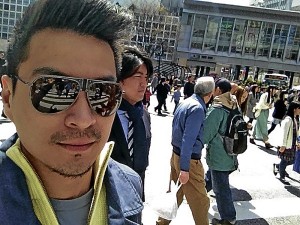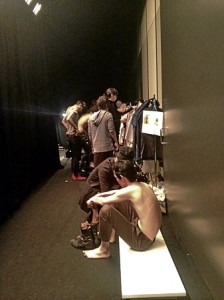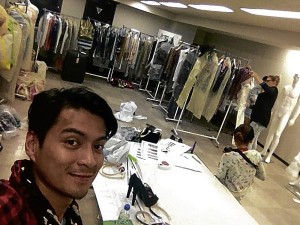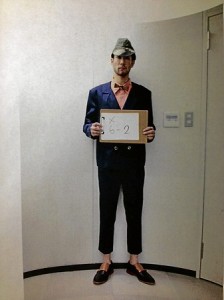
Before becoming the first Filipino to be accepted into Japan’s Vantan Design Institute, designer Johann Manas didn’t want to jinx the whole thing, so he kept it a secret, even from his own family.
Under the guise of going to Tokyo on holiday, Manas flew to Japan for his scheduled interview with the academy, but was unable to make the interview because he found himself brought instead to one of the refugee centers set up for survivors of the 2011 earthquake that hit Japan.
“A kind stranger brought me back to Narita, and I had to return home, but it was a minor setback,” said Manas.
After a rescheduled interview and finally letting his family in on his dream to study in Tokyo, Manas received his certificate of admission in late 2011, becoming the first Filipino to attend the school.
 Now in the academy for almost a year, he is under the tutelage of five different senseis: one each for fashion, production design, pattern, business and textile and print. His teachers come from different parts of the fashion industry; one is a consultant for Uniqlo, Dries Van Noten and Helmut Lang, another used to do patterns for Kenzo.
Now in the academy for almost a year, he is under the tutelage of five different senseis: one each for fashion, production design, pattern, business and textile and print. His teachers come from different parts of the fashion industry; one is a consultant for Uniqlo, Dries Van Noten and Helmut Lang, another used to do patterns for Kenzo.
As part of their curriculum, Vantan Design Institute students are required to come up with a collection to be shown at the Mercedes-Benz Fashion Week in Tokyo.
Super checked in with Johann in Tokyo several months back while he was conceptualizing the collection.
Why did you choose to study design in Japan?
Though I was dabbling in design here in Manila prior to leaving, I was already designing shoes and did Fashion Watch with Jun Escario. I also designed a pair of brogues for Lucky Manzano, and I have a T-shirt line (JMan). I felt like I needed to get out of my comfort zone. I’ve always wanted to do something creative and be in a place that had inspiration in every nook and cranny, and for me that place was Tokyo.

I had my share of culture shock (laughs). I sometimes feel like I’m turning Japanese already, all quiet and unfailingly polite. I really love the atmosphere here. School is tough, but it’s really amazing to be studying under such great minds. I’m always amazed and it’s very, very inspiring to be here, not just in Tokyo, but everywhere in Japan. We even took the midnight bus to Nagoya once to check indigenous fabrics being done by artisans in their factories. I’ve adapted well to the Japanese lifestyle, I don’t even have a train pass! I just take my bike wherever.
What was your inspiration for your first collection for Tokyo Fashion Week?
I was inspired by classic silhouettes, and my love for camouflage translated itself into repeating patterns for my pieces. I also love utilitarian work wear, so you’ll find a lot of pieces that you can mix and match. I also added bursts of color like apple green and salmon pink into denim.
I handpicked the colors myself and got denim from factories in Okayama, which is known as “denim town” here in Japan. My patterns were also created by me. I also did collar-less coats, but kept the lapels and incorporated a lot of drop shoulders. I wanted no shoulder lines.

I was originally set to focus on “aizome,” which is the Japanese word for indigo dye. I really loved the color and wanted to work with this shade and technique for my patterns. However, a schedule snafu prevented me from fixing an error in the printing.
I was still in love with the idea of repeating patterns, so I brought my designs back to Manila and looked for an embroiderer. Instead of aizome, I incorporated hand embroidery into my menswear, which I felt was unique since embroidery is associated more with women and barong tagalog.
I was so thrilled that it was so well-received by my senseis; they encouraged me to put more of my Filipino heritage into my designs and make it modern. Some of my women friends are even asking for me to make that sweater with the embroidered sleeves for them!
 I’m so happy that my shoe designs, which were entirely made in Manila using Japanese materials, received praises as well. A friend of mine from Prada really loved it! It makes me so happy to be able to bring a Filipino touch to what I learned in Tokyo.
I’m so happy that my shoe designs, which were entirely made in Manila using Japanese materials, received praises as well. A friend of mine from Prada really loved it! It makes me so happy to be able to bring a Filipino touch to what I learned in Tokyo.
What’s your menswear philosophy?
I’m a mood-based dresser. Design-wise, you don’t always have to innovate, but you do have to make something yours. I want to introduce color to a man’s closet to help him stand out, and I also like to create classic silhouettes with a twist, like a pair of brogues that I designed in an oxblood hue.
I love wearing that, and I can even wear it while biking in Tokyo. Dressing to suit the weather is also very important, and I value function, too. Take a pair of jeans, for example. Most men immediately have the hem trimmed according to their height, but I love to leave the hem a little long. It makes your jeans versatile for any type of weather; if it’s hot you can roll up the hem, and then take it down when the weather starts to become chilly again.
Who would you consider Manila’s best-dressed men?
Jappy Gonzales of Homme et Femme; Erwan Heusaff, I like how he mixes trends with classic pieces; John Lloyd Cruz—I’d love to design for him; and Rafa Alunan, because he always looks very polished.
What are classic pieces every man should have in his closet?
A pair of brogues, a Panama hat, Doc Martens—I’m a fan—a nice tote or satchel, a versatile timepiece, a crisp white shirt and jeans. Jeans are very important; one shouldn’t be afraid to spend on jeans since a great pair can last you years. Fabric is very important when looking for that perfect pair of jeans.
How was it like to show your designs at Tokyo Fashion Week?
It was so amazing! I actually thought that as students we would be doing everything, but I was so surprised at how professional the whole thing was. We even had people whose only tasks were to dress the models while some were just tasked to remove lint from the clothes. And the models would get massages before getting made up. It’s all still so surreal to me (laughs).
What’s next in store for you?
I’m now working on my collection for Autumn-Winter 2013. It’s still unclear where exactly, but we may join either New York, London or Paris Fashion Week so we’re all preparing for that. It’s very exciting!
Visit Johann Manas at www.jman.ph









































